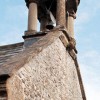On the north side of the nave of the parish Church of St. Michael the Archangel in Lyme Regis there is a piece of craftsmanship in embroidery on display which has been the subject of much controversy ever since it was acquired for the church in the latter 19th century.
This possession is the Lyme Tapestry, widely supposed to be the work of Flemish weavers around 1490, but still veiled in uncertainty over the identity of the people involved in the marriage or betrothal the tapestry portrays. Some authorities hold that it depicts the marriage of Henry VII and Elizabeth of York, while others consider it could equally represent that between Henry VIII (or his brother Prince Arthur) and Catherine of Aragon. However, the work shows a pomegranate – the emblem of the recently conquered Granada and a clerical figure presumed to be Cardinal Wolsey – a high churchman unknown in Henry VII’s reign.
Whichever is correct this textile has had a chequered history. The connection with Lyme began on the day in 1886 when the vicar, the Revd. Edward Peek bought it for the church from an obscure source for £20. The story goes that until the time of the purchase the tapestry had been concealed behind a false wall at the Somerset home of a Royalist anxious to secure such a treasure from plunder by Cromwellian forces during the Civil War. The tapestry hidden for over 200 years; the house however, has never been traced.
In January 1912 the Revd. W. Jacob was informed after consultation with a valuer that the tapestry was worth between £1,500 and £2,000. Over the next 41 years there followed a long series of correspondence and consultations between the Church Council and a curator at the Victoria and Albert Museum about the possible acquisition of the tapestry for the Museum.
Then in 1953 the President of the Royal Academy of Arts wrote to the vicar of Lyme asking if the tapestry could be loaned for an exhibition to mark the Coronation. As the piece was only insured against fire and the church had no money for its upkeep, the tapestry was not released on this occasion; the exhibition was cancelled. Twenty-two years later the Revd. Nicholson, concerned about the tapestry’s condition and maintenance costs, sought to donate it to a museum, but the tapestry did not come to be moved on this occasion either.
Following this the Church Council decided unanimously to place the work with a museum or art gallery in the southwest, and in 1977 an arrangement was made to place the tapestry in the custody of the National Trust at its Barn Restaurant property at Trerice in Cornwall. Here it remained until 1996 when, following negotiations with the Trust and some preparatory conservation work undertaken at Hampton Court, the Lyme Tapestry was returned and re-hung in St. Michael’s.



